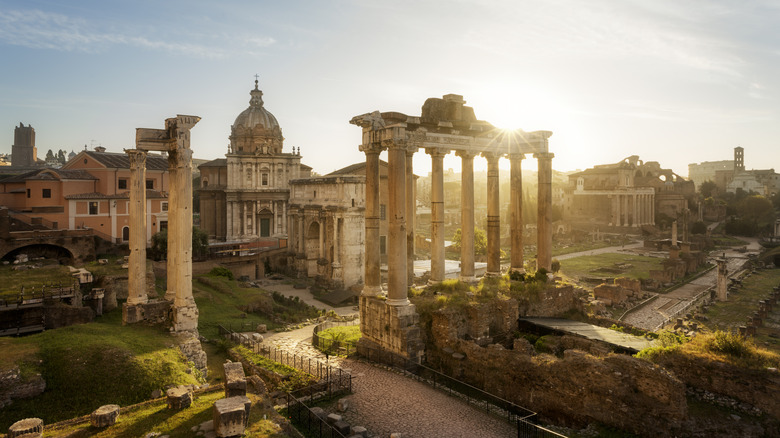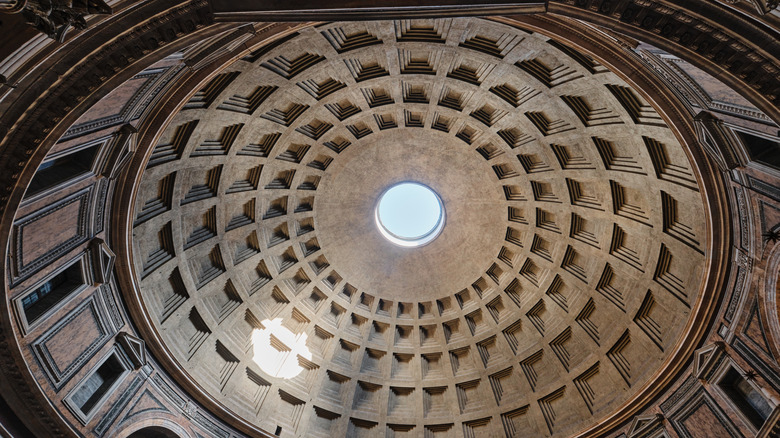One Of Italy's Oldest Attractions Blends Divine Geometry, Celestial Light, And Roman Mystery
Italy is home to some of the world's oldest and most renowned tourist attractions. It's easy to spend a day doing what Rick Steves has called the "Caesar Shuffle" and visit them all in one fell swoop. The Colosseum, the Forum, the Sistine Chapel, the Trevi Fountain, and many other iconic sites are located within walking distance of each other, alongside the Pantheon, one of Rome's oldest and most enigmatic landmarks.
The Pantheon is one of Rome's most visited tourist destinations, seeing about nine million visitors each year in the world's largest unreinforced concrete dome. Unlike other open-air monuments and temples, the Pantheon is somewhat of a mystery, as it sports a giant hole in the ceiling despite its otherwise entirely enclosed space. Yes, some rain does enter the Pantheon through the ceiling hole. But since being reconstructed in 126—128 A.D. after damage from a fire, the ancient building has somehow avoided major flooding and other kinds of disasters.
No longer free for tourists, the entrance fee to visit the Pantheon is only €5 (or just under $6) per individual, though entry is free for children and residents of the city of Rome. Once you're in Rome, you can get to this destination on foot, via the metro or a bus, or even on a guided tour. Just be sure to stay alert on the infamous bus in Rome known as the "Pickpocket Express," which stops at several popular tourist spots.
Why is there a hole in the ceiling of the Pantheon?
One of the best-maintained ancient buildings in all of Rome, the Pantheon is famously covered by a large dome. The massive hole in the ceiling — the oculus or "eye" — may seem strangely inappropriate for an indoor temple. However, it's this feature that has structurally helped keep the ancient building standing for so long. After the building's reconstruction and reopening around 128 A.D., it served as a Roman temple for several hundred years before being redesignated as a Catholic Church in 609 A.D.
The dome is entirely unreinforced, the oculus in the ceiling providing support. Without it, or even with a smaller opening, engineers believe it would have collapsed. Apart from contributing to structural integrity, the hole in the Pantheon serves multiple purposes. There are no other open windows in the temple; all sunlight that comes into the building does so through the 30-foot diameter hole in the ceiling. The opening is also believed to connect the Pantheon and the worshippers inside to the gods. Pantheon in Greek means "honor all Gods" or "a temple to all Gods."
How to visit the Pantheon
You may have to wait in line for a while to enter the Pantheon during the summer high tourism season (June, July, and August). But other than that, getting in is pretty straightforward. Tickets can be purchased either in person at the Pantheon's ticket office or online from the Pantheon's website. Buying tickets in person provides flexibility if you're unsure when you'll be able to make it to the temple. If you choose this option, arrive at the site, and see that the line is looking a bit too long for your liking, just saunter over to another destination and return later in the day. After all, Rome was ranked the world's most walkable city in 2025.
Another option if you plan to visit several attractions in the Pantheon's vicinity or simply don't want to deal with buying tickets is to join a guided tour. These are more expensive than entering on your own (depending on the nature of the tour and how long it is), but you'll also be provided with additional information about the building's history that you may not get wandering in alone. Past visitors recommend visiting the Pantheon in a self-guided capacity, as the viewable portion is quite small — contained in a single room. If you plan an extended stay in Rome and wish to purchase tickets to multiple attractions (e.g., museums, churches, and ruins) a Rome tourist pass might be the right option for you.


